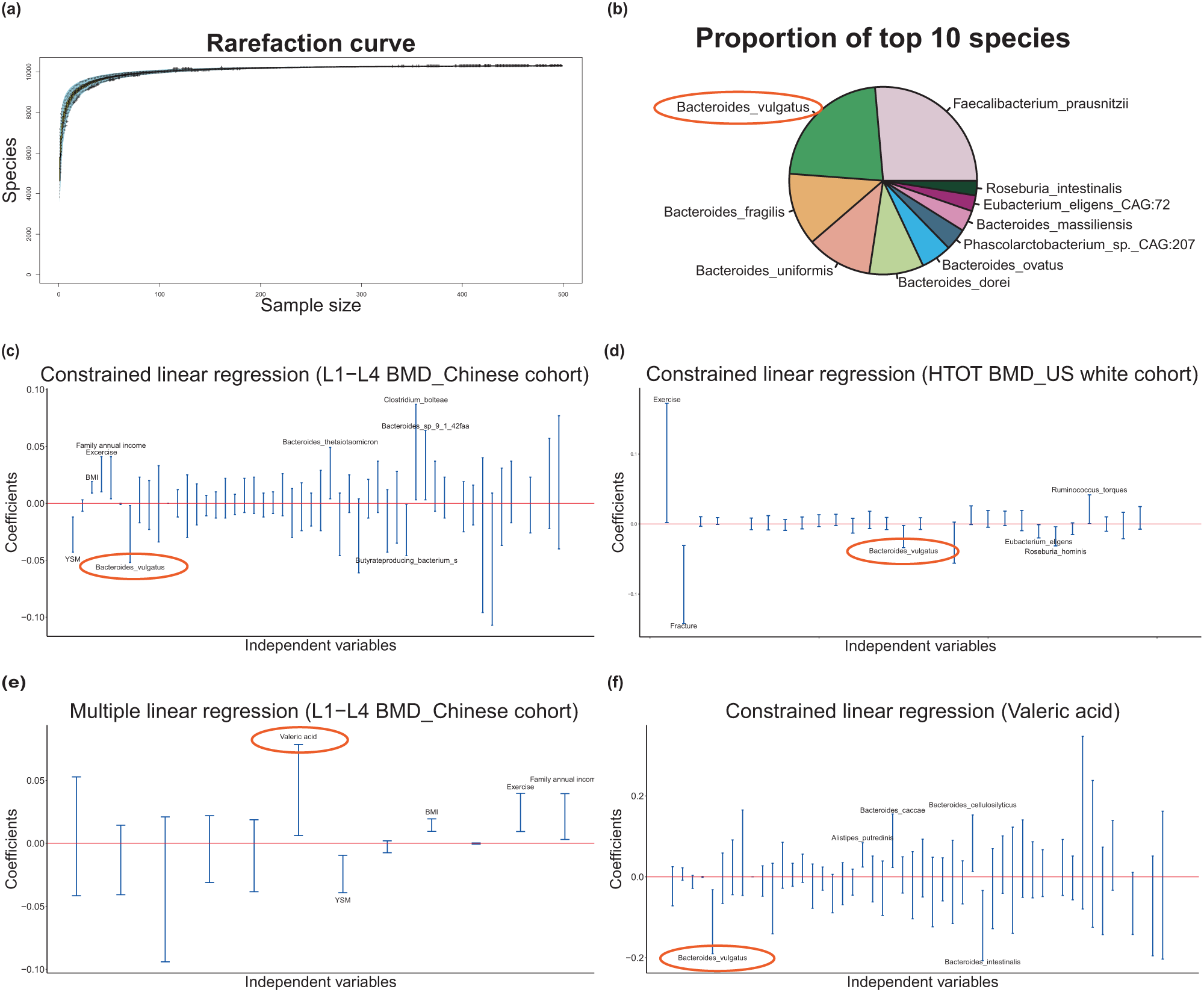Although the gut microbiota has been reported to influence osteoporosis risk, the individual species involved, and underlying mechanisms, remain largely unknown. A team led by Southern Medical University performed integrative analyses in a Chinese cohort of peri-/post-menopausal women with metagenomics/targeted metabolomics/whole-genome sequencing to identify novel microbiome-related biomarkers for bone health. They used LC Sciences’ Metagenomic Sequencing service on extracted DNA from fecal samples of the women in the study. Bacteroides vulgatus was found to be negatively associated with bone mineral density (BMD), which was validated in US white people. Serum valeric acid (VA), a microbiota derived metabolite, was positively associated with BMD and causally downregulated by B. vulgatus. Ovariectomized mice fed B. vulgatus demonstrated increased bone resorption and poorer bone micro-structure, while those fed VA demonstrated reduced bone resorption and better bone micro-structure. VA suppressed RELA protein production (pro-inflammatory), and enhanced IL10 mRNA expression (anti-inflammatory), leading to suppressed maturation of osteoclast-like cells and enhanced maturation of osteoblasts in vitro. The findings suggest that B. vulgatus and VA may represent promising targets for osteoporosis prevention/treatment.
Bacterial species composition and associations among bacterial speices, SCFAs and BMD
a Rarefaction curve: the number of bacterial species (Y-axis) was plotted against the number of samples (X-axis, n = 499). b Bacterial species composition in the study cohort composed of top 10 bacterial species. c−f Bacterial species/SCFAs related to BMD/VA in the Chinese cohort and US cohort by constrained linear regression analysis or multiple linear regression analysis. Regression coefficients (Y-axis) were plotted against independent variables (X-axis). Species/SCFAs and covariates were considered as independent variables and represented by the blue lines. The length of the blue line indicates the 95% confidence interval (CI). c L1-L4 BMD-related species of Chinese cohort (n = 499); d HTOT BMD-related species of the US white cohort (n = 59); e L1-L4 BMD-related SCFAs of Chinese cohort (n = 500); f Valeric acid-related species of Chinese cohort (n = 499). Source data are provided as a Source Data file. SCFAs short chain fatty acids, BMD bone mineral density, L1-L4 lumbar spine, HTOT left total hip, YSM years since menopause, BMI body mass index.
Lin Xu, Xiao Hong-Mei, Liu Hui-Min, Lv Wan-Qiang, Greenbaum Jonathan, Gong Rui, Zhang Qiang, Chen Yuan-Cheng, Peng Cheng, Xu Xue-Juan, et. al. (2023) Gut microbiota impacts bone via Bacteroides vulgatus-valeric acid-related pathways. Nature Communications 14(1), 6853. [article]
Although the gut microbiota has been reported to influence osteoporosis risk, the individual species involved, and underlying mechanisms, remain largely unknown. A team led by Southern Medical University performed integrative analyses in a Chinese cohort of peri-/post-menopausal women with metagenomics/targeted metabolomics/whole-genome sequencing to identify novel microbiome-related biomarkers for bone health. They used LC Sciences’ Metagenomic Sequencing service on extracted DNA from fecal samples of the women in the study. Bacteroides vulgatus was found to be negatively associated with bone mineral density (BMD), which was validated in US white people. Serum valeric acid (VA), a microbiota derived metabolite, was positively associated with BMD and causally downregulated by B. vulgatus. Ovariectomized mice fed B. vulgatus demonstrated increased bone resorption and poorer bone micro-structure, while those fed VA demonstrated reduced bone resorption and better bone micro-structure. VA suppressed RELA protein production (pro-inflammatory), and enhanced IL10 mRNA expression (anti-inflammatory), leading to suppressed maturation of osteoclast-like cells and enhanced maturation of osteoblasts in vitro. The findings suggest that B. vulgatus and VA may represent promising targets for osteoporosis prevention/treatment.
Bacterial species composition and associations among bacterial speices, SCFAs and BMD
a Rarefaction curve: the number of bacterial species (Y-axis) was plotted against the number of samples (X-axis, n = 499). b Bacterial species composition in the study cohort composed of top 10 bacterial species. c−f Bacterial species/SCFAs related to BMD/VA in the Chinese cohort and US cohort by constrained linear regression analysis or multiple linear regression analysis. Regression coefficients (Y-axis) were plotted against independent variables (X-axis). Species/SCFAs and covariates were considered as independent variables and represented by the blue lines. The length of the blue line indicates the 95% confidence interval (CI). c L1-L4 BMD-related species of Chinese cohort (n = 499); d HTOT BMD-related species of the US white cohort (n = 59); e L1-L4 BMD-related SCFAs of Chinese cohort (n = 500); f Valeric acid-related species of Chinese cohort (n = 499). Source data are provided as a Source Data file. SCFAs short chain fatty acids, BMD bone mineral density, L1-L4 lumbar spine, HTOT left total hip, YSM years since menopause, BMI body mass index.
Lin Xu, Xiao Hong-Mei, Liu Hui-Min, Lv Wan-Qiang, Greenbaum Jonathan, Gong Rui, Zhang Qiang, Chen Yuan-Cheng, Peng Cheng, Xu Xue-Juan, et. al. (2023) Gut microbiota impacts bone via Bacteroides vulgatus-valeric acid-related pathways. Nature Communications 14(1), 6853. [article]

